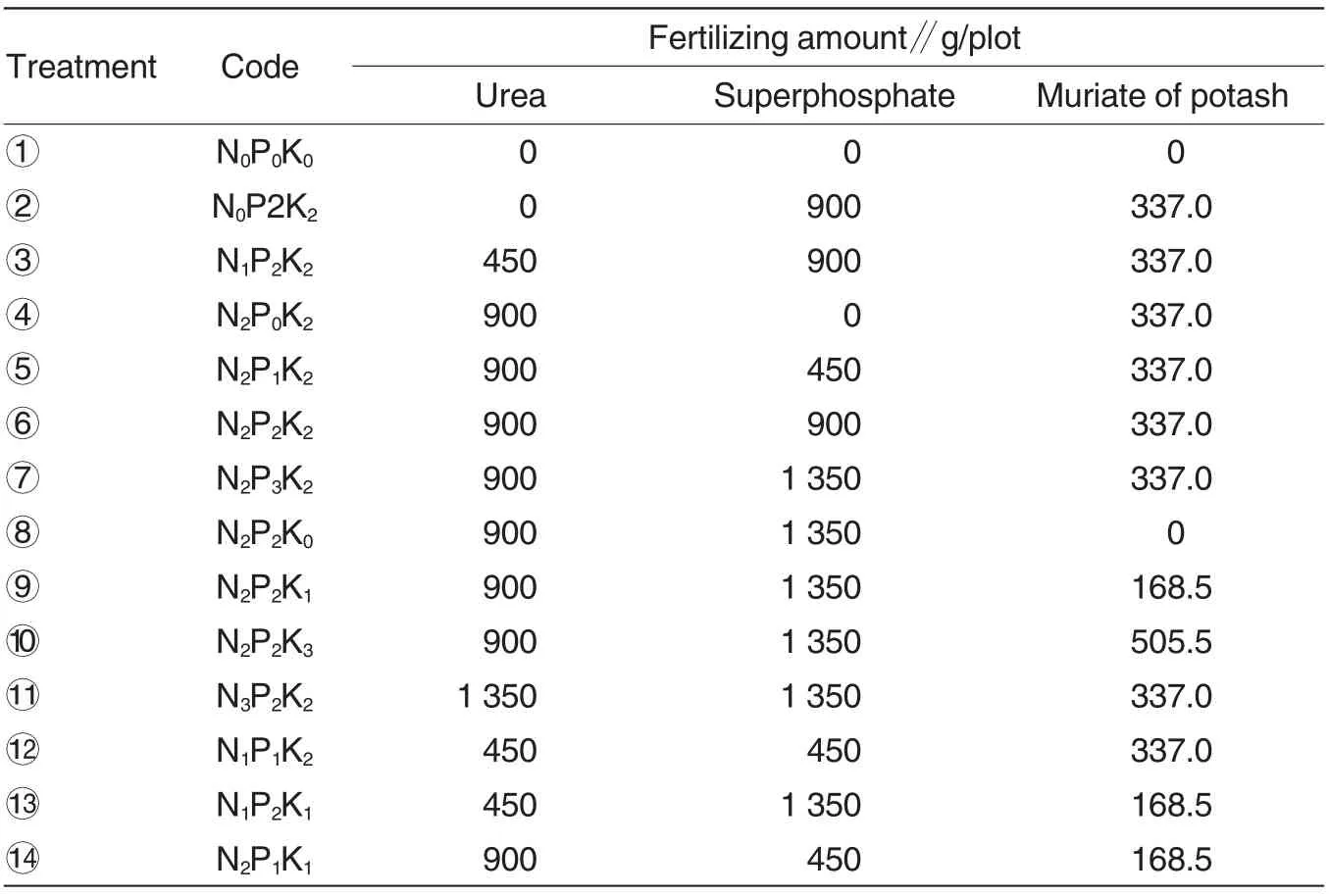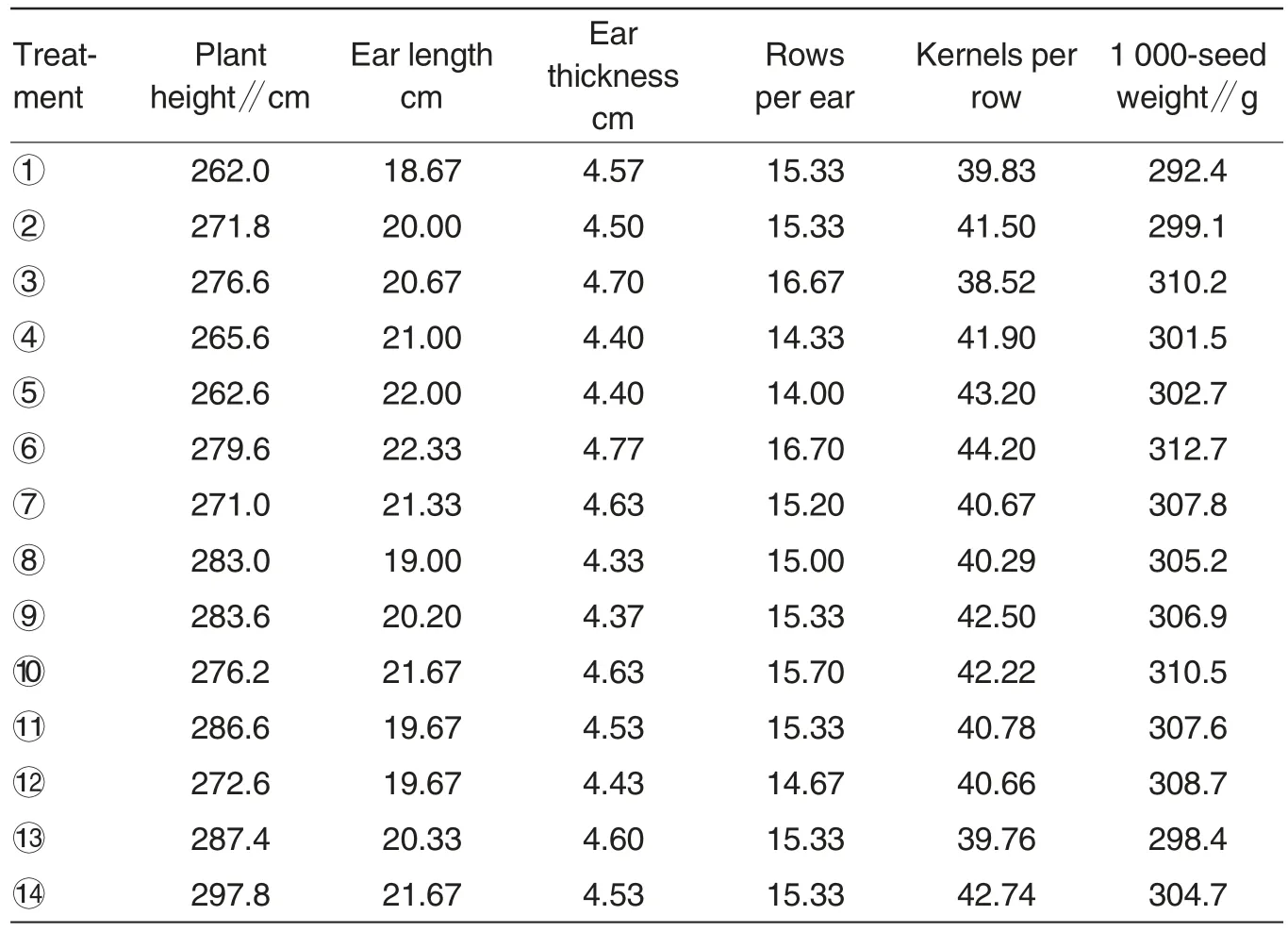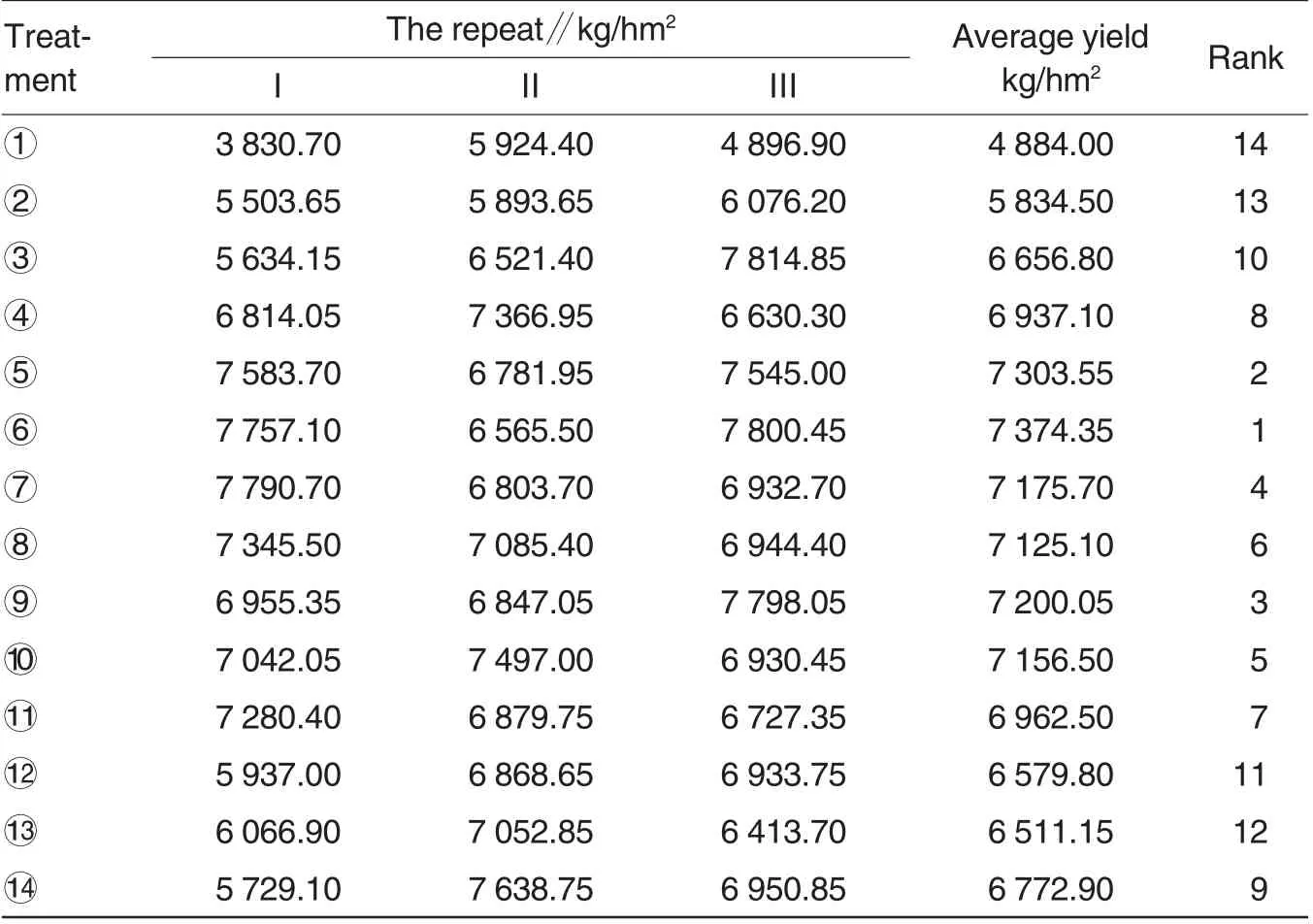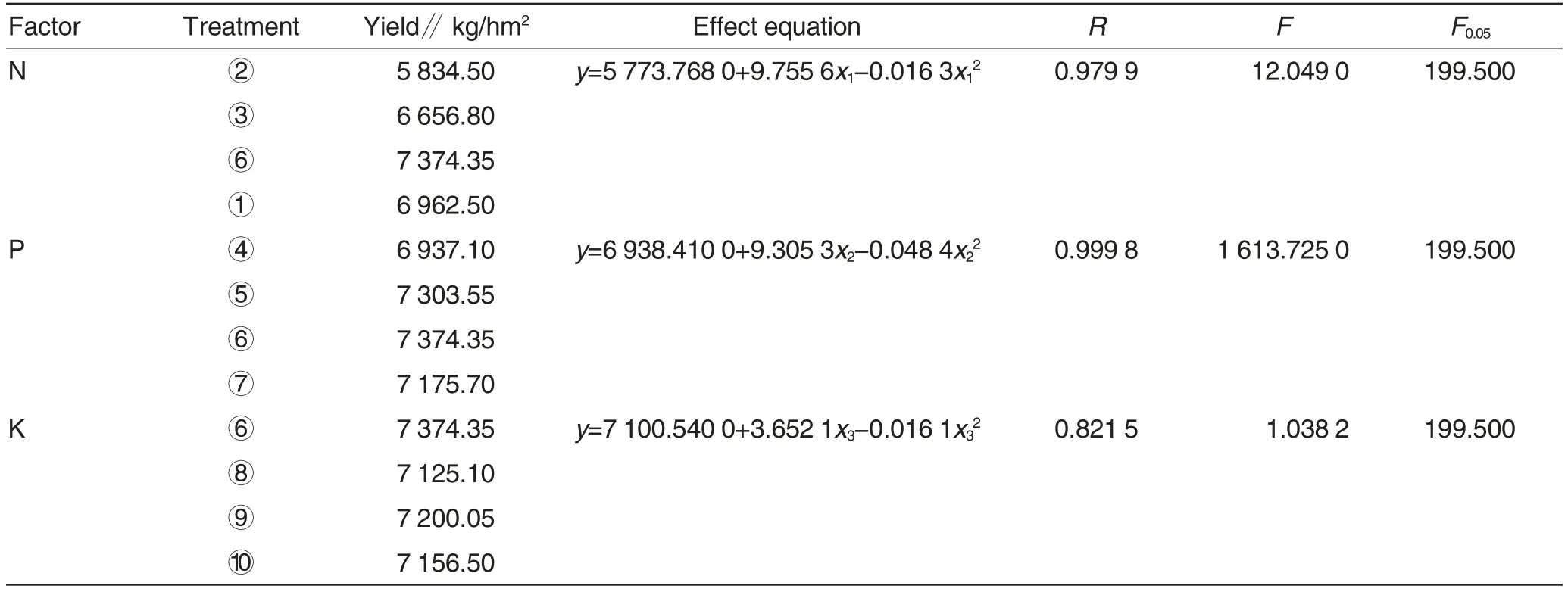Effects of Different N,P and K Fertilizer Levels on Growing Characters and Yield of Corn
2015-12-14DeweiZHONGYanDENGZhukeKANGZhenghuiHUANGXiaoxiTIAN
Dewei ZHONG, Yan DENG, Zhuke KANG, Zhenghui HUANG, Xiaoxi TIAN
1. Suijiang County Soil Fertilizer Work Station in Yunnan Province/The Extension Center of Agricultural Technology in Suijiang County of Yunnan Province, Suijiang 657700, China;
2. Sujiang Agricultural Regionalization Office in Yunnan Province,Suijiang 657700, China;
3. Suijiang Plant Protection and Quarantine Station in Yunnan Province,Suijiang 657700, China
For China,a country with a large population, its grain production is vital to national wellbeing and people’s livelihood, thus it has an important practical significance[1]. Especially for Suijiang County, a large immigration county with nearly 6×104urban and rural residents needing to be relocated and resettled caused by the construction of Xiangjiaba Power Station which is a national large hydropower station,so its cultivated land decreased and grain production faced serious situation, therefore, it is particularly important to stress grain production and ensure food security.Suijiang County is a typical agricultural county in mountain areas and located in the south of Jinsha River, North Zhaotong City, the northeast corner of Yunnan Province,its main food crop is corn, the perennial cultivated area is 6 666.7 hm2and total yield is 1.88×104t, moreover, the cultivated area and total yield rank the first in the whole county, and respectively account for 41.7%and 45%of total cultivated area and total yield of the whole county[2]. To further improve corn yield and explore measures for saving cost and improving efficiency in Suijiang,according to the requirements of Technical Manual of Soil Testing and Fertilizer Recommendation and Implementation Plan of "3414" Field Fertilizer Efficiency Experiment of Spring Crops in Suijiang County by Ministry of Agriculture of the People’s Republic of China in 2012, on the basis of the existing fertility conditions of farmland soil, the field fertilizer efficiency experiment of corn was carried out, and the optimum fertilization scheme for corn in the region was studied, so as to provide scientific guidance for corn production in Sui-jiang County.
Materials and Methods
General situation of the experiment
The experiment was carried out in Hu’s contracted land in Group 6 of Nan’an Village, Nan’an Town, Suijiang County, which is located at 28°39′18″N and 103°51′29″E,and the altitude is 833 m, the soil is yellow loam—yellow soil—limestone—large mud, and the preceding crop was wheat. The terrain of the experiment land is flat,soil fertility is moderate and uniform, the collected soil samples were detected, and the constituents were as follows:pH 6.4,19.6 g/kg organic matter, 100 mg/kg available nitrogen, 5.2 mg/kg available phosphorus and 94 mg/kg rapidly available potassium. The tested maize variety was hybrid Chengyu 9, and the tested fertilizers were urea (containing 46%pure N), superphosphate (containing 18% P2O5) and muriate of potash(containing 60%K2O).
Experiment design
"3414" fertilizer effect experiment program was adopted[3], there were three elements like N,P and K(276 kg pure N, 108 kg P2O5and 135 kg K2O,and these were the relative optimum amount of fertilization per hm2in the region) , four levels and 14 treatments(in Table 1).
Hereinto,"0 level”represented no fertilizer, "1 level" represented half of"2 level" value, "2 level" represented the relative optimum amount of fertilization which was the nearest to local ideal condition, "3 level" represented 1.5 times of "2 level" value. The fertilizer rate of each plot was as follows:"1 level"contained 450 g urea,450 g superphosphate and 168.5 g muriate of potash; "2 level"[4]contained 900 g urea,900 g superphosphate and 337 g muriate of potash; "3 level" contained 1 350 g urea,1 350 g superphosphate and 505.5 g muriate of potash. The plot area was 15 m2with 5 m in length and 3 m in width.There were totally 42 plots with randomized block design of three replications,the aisle was 60 cm between the repeat, the guard rows were set around the experiment land.Phosphate fertilizer and potash fertilizer were all used as base fertilizer,10% nitrogenous fertilizer was also used as base fertilizer, and the others were used as topdressing,the proportions of fertilizer for seed bed, jointing fertilizer and fertilizer for head sprouting were respectively 20%, 30% and 40%.

Table 1 The design of corn"3414"field fertilizer efficiency experiment
Experiment implementation
The breeding technique of corn nutrition group was adopted to transplant and plant closely,the sowing and transplanting dates were respectively on May 17 and May 27,the row spacing and plant spacing were respectively 1 m and 23.8 cm, the planting density was 42 000 plants/hm2. The topdressing dates of fertilizer for seed bed, jointing fertilizer and fertilizer for head sprouting were respectively on June 9,June 30 and August 6,and the harvesting date was on September 20.Other cultivation and management measures were the same as extensive production.
Results and Analyses
Comparison on the performance of growth characters under different treatments
As shown in Table 2, plant height and ear length increased with the increase of application amount of N fertilizer and had not obvious relationship with P and K fertilizers; rows per ear,kernels per row and 1 000-seed weight all showed the trend of increasing firstly and decreasing then with the increase of N fertilizer.The comprehensive characters of ear length,ear thickness, rows per ear, kernels per row and 1 000-seed weight of treatment ⑥were all better, thus it was hoped to significantly improve corn yield. Overall, the economic characters of corn showed the trend of increasing firstly and decreasing then with the increase of N,P and K fertilizers.
Comparison on the effect of corn yield under different fertilization treatments
As seen in Table 3, in the condition of no N,P and K fertilizers(N0P0K0treatment), the yield of corn was less than that of all the other treatments,and only 4 884.00 kg/hm2; and the yield under treatment ⑥was the highest and reached 7 374.35 kg/hm2.From single factor, eliminating the interference of other nutritive elements,the yield of treatments ②, ③, ⑥and①generally showed the trend of increasing firstly and decreasing then with the increase of N fertilizer; the yield of treatments ④, ⑤, ⑥and ⑦showed the trend of increasing firstly and decreasing then with the increase of P fertilizer;the yield of treatment ⑥,⑧, ⑨and ⑩showed the trend of increasing firstly and decreasing then with the increase of K fertilizer. In all,the corn yield under different fertilization treatments had differences at different degrees, but generally showed the trend of increasing firstly and decreasing then,which accorded with the law of diminishing returns of fertilizer[5].
Analysis on ternary quadratic fertilizer efficiency equation According to the data information about corn yieldunder different fertilization treatments in Table 3, operational analysis was carried out using "3414" field experiment design and data analysis management system"[6], the fertilizer efficiency equation about nitrogen (N),phosphorus (P2O5) and potassium(K2O)was got as follows:
In the formula, y represented yield, x represented fertilizer rate, x1represented N, x2represented P2O5, x3represented K2O, the unit was kg/hm2.At the same time, correlation coefficient (R) was 0.985 7, standard error(Sy)was 204.492 3.By variance analysis, F=15.231 9>F0.01=14.659 1, indicating that the yield had extremely significant regression relationship with the application amount of N, P and K fertilizers.

Table 2 The performance of growth characters of corn under different treatments

Table 3 The effect of corn yield under different treatments

Table 4 The one-variable quadratic model equation and variance analysis under different treatments
Analysis on one-variable quadratic fertilizer efficiency equations According to the specific treatment in the experiment, operational analysis was carried out with the help of"3414"field experiment design and data analysis management system",the fertilizer efficiency equations about N, P and K single factor fertilizers were got (in Table 4). The F values of each efficiency equation, except that of P factor,were all less than the corresponding F0.05values, thus each efficiency equation can better reflect the relationship between local fertilizer and corn yield.
The application of fertilizer efficiency model equations
The maximum yield and the optimum amount of fertilization of ternary quadratic regression equation "3414" field experiment design and data analysis management system" was used for analyzing, which drew a conclusion that when pure N,pure P2O5and pure K2O were respectively 317.84, 118.80 and 158.33 kg/hm2, the best yield of corn was 7 203.05 kg/hm2. Referring to local market prices of rice and different fertilizers(the prices of corn,pure N,pure P2O5and pure K2O were respectively 2.80,5.43,7.78 and 8.00 RMB/kg),the optimum amount of fertilization and the maximum return were calculated, and obtained that when pure N, pure P2O5and pure K2O were respectively 244.38, 58.75 and 107.38 kg/hm2,the best yield of corn was 6 975.60 kg/hm2,and the maximum benefit was 16 888.58 RMB/hm2.
The maximum yield and the optimum amount of fertilization of onevariable quadratic regression equation When pure N was 298.65 kg/hm2, the maximum yield of corn was 7 230.53 kg/hm2; when pure N was 282.87 kg/hm2, the optimum yield was 7 226.46 kg/hm2and the maximum benefit was 17 158.02 RMB/hm2.When pure P2O5was 96.03 kg/hm2,the maximum yield of corn was 7 385.22 kg/hm2; when pure P2O5was 92.32 kg/hm2,the optimum yield was 7 384.55 kg/hm2and the maximum benefit was 17 600.67 RMB/hm2. When pure K2O was 113.62 kg/hm2,the maximum yield of corn was 7 308.02 kg/hm2; when pure K2O was 102.73 kg/hm2,the optimum yield was 7 306.11 kg/hm2and the maximum benefit was 17 381.04 RMB/hm2.
Conclusions and Discussions
(1) Under the optimal application amount of N, P and K fertilizers, the growing indexes of corn like ear length, ear thickness, rows per ear,kernels per row and 1 000-seed weight showed greater superiority than the other treatments,thus it was hopeful to significantly improve corn yield.
(2)One-variable quadratic fertilizer efficiency equations of corn yield and application amount of fertilizer nutrient in the experiment were consistent with previous research results[7-12],the correlation coefficient of ternary quadratic efficiency equation was 0.985 7, thus reaching the extremely significant level of 99%.The maximum yield, the optimum yield and the corresponding fertilizing amount predicted by the fitting effect equations coincided with actual production, thus conforming to local actual situations.
(3) It was suggested that the optimum fertilization scheme for corn in the region was as follows: when pure N, pure P2O5and pure K2O were respectively 244.38, 58.75 and 107.38 kg/hm2,the obtained best yield of corn was 6 975.60 kg/hm2, and the maximum benefit was 16 888.58 RMB/hm2.
(4) In the experiment, the study was only carried out in Suijiang County and; to establish a perfect fertilizer technique system for corn in the County, it still needs to carry out experiments in different places for many years.
[1]CHEN XP (陈新平),ZHANG FS (张福锁).On the establishment of index system of soil testing and formulated fertilization by "3414" experiment ( 通过“3414”试验建立测土配方施肥技术指标体系)[J].China Agricultural Technology Extension(中国农技推广),2006,22(4):36-39.
[2]Committee for the Compilation of Suijiang County Local Chronicles (绥江县地方志编纂委员会). Suijiang County Yearbook (绥江县年鉴)[M]. Luxi: Dehong Nationalities Publishing House(潞西:德宏民族出版社),2012:39.
[3]Ministry of Agriculture of the People’s Republic of China(国家农业部).Technical manual of soil testing and fertilizer recommendation(2011)(测土配方施肥技术规范(2011 年修订版))[S].
[4]ZHANG FS (张福锁). Soil testing and fertilizer recommendation technology(测土配方施肥技术)[M]. Beijing: China Agricultural University Press(北京:中国农业大学出版社),2011:82.
[5]CHEN LS (陈伦寿).Law of diminishing returns and rational application of fertilizer(报酬递减律与合理施肥)[J].Journal of China Agricultural University (北京农业大学学报),1982,8(1):69-76.
[6]The National Agricultural Technology Extension Service Center (全国农业技术推广服务中心). "3414" field experiment design and data analysis management system(“3414”田间试验设计与数据分析管理系统)(2.0 For Winxp With DotNet 2.0)[Z].2008.
[7]XU JR(徐金荣),CHEN LM(陈丽梅),LIU M (刘梅).Studies on fertilization model for spring maize in Jilin Province (吉林春玉米施肥模型的研究)[J]. Journal of Anhui Agricultural Sciences(安徽农业科学),2010,38(33):18839-18841.
[8]HAN ZF (韩振锋). Result analysis of corn 3414 fertilizer experiment (玉米“3414”肥料试验结果与分析) [J].Shanxi Science and Technology (山西科技),2011(3):140-141.
[9]XING YH (邢月华), WANG R (汪仁),BAO HJ (包红静),et al.Effects of different phosphorus application amounts on yield, profit and nutrient uptake of maize (不同磷肥用量对玉米产量·效益及养分吸收的影响)[J].Journal of Anhui Agricultural Sciences (安徽农业科学),2011,39(32):19834-19835,19923.
[10]WANG Y (王勇), WU QY (吴清毅),CHEN Z (陈卓), et al. Study on corn 3414 fertilizer effect experiment in Meitan County of Guizhou Province(贵州省湄潭县玉米“3414”肥效试验研究) [J]. Beijing Agriculture (北京农业),2011(15):60-61.
[11]SUN SR(孙树荣),ZHOU JC(周进财).Fertilizer effect of "3414" experiment on dryland corn in Xinzhou (忻州旱地玉米 “3414” 试验肥料效应分析)[J].Journal of Shanxi Teachers University(山西师范大学学报),2012,26 (3):75-78.
[12]CAO QH(曹群虎),MU F(慕芳),DUAN CL (段长林).Study on"3414"fertilizer effect of corn in Changwu County (长武县玉米“3414”肥效研究)[J].Journal of Anhui Agricultural Sciences (安徽农业科学),2014,42(2):414-416.
杂志排行
Agricultural Science & Technology的其它文章
- Evaluation on Suitability of Camellia sinensis Planting Based on GIS
- Light Quality-controlled Phytochemicals Biosynthesis in Vegetables and Fruits
- Cloning and Characterization of Phytochrome A Gene FaPHYA from Tall Fescue
- Genetic Analysis of Embryo Production Frequency in Wheat×Maize Cross
- The Application Effects of Truly Biodegradable Mulch in Potato Farmlands
- The Analysis and Prospect of Development of Fresh Cut Flower Industry Based on the Patent Analysis
